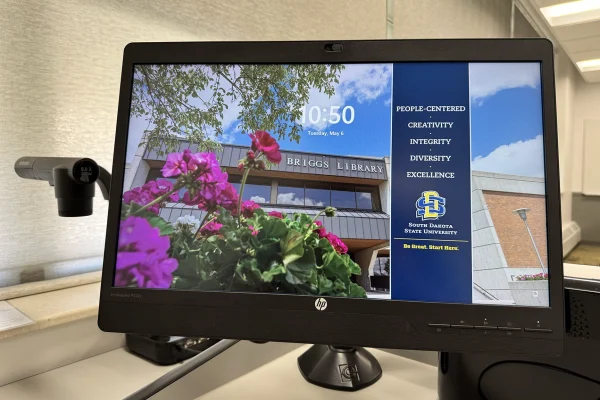New School of American and Global Studies serves as ‘intellectual, cultural core of SDSU’
October 29, 2019
Christi Garst-Santos hasn’t done much reading lately. The Cervantes and Spanish literature scholar has had to cast aside her usual intake of reading to lead the newly established School of American and Global Studies as its director.
After a two-year process, the school went live on July 1, 2019 and houses 12 programs—American Indian studies, French, German, global studies, history, Lakota, legal studies, philosophy, political science, religion, Spanish and workplace intercultural competence. There are 686 students in AGS.
“I like to say that we’re (the) intellectual and cultural core of SDSU,” Garst-Santos said. “They are disciplines that make you a better thinker and that make you interculturally competent—all those soft skills employers are looking for.”
An American and Global Studies school is unique in the state and region of South Dakota. Usually, according to Garst-Santos, you find these schools within larger universities like University of Minnesota or Michigan.
Combining language studies with programs like political science and legal studies under one roof provides new opportunities for students. The new school has many upcoming initiatives to support students who want to learn more about policy and culture.
These programs aren’t live yet, but Garst-Santos is working in her role to flesh out the details. Programs she is working on establishing include: a polyglot certificate (for students who study multiple languages), a lobbying and advocacy certificate, a Wizipan leadership and sustainability certificate and a medical humanities minor.
“Of course, we kept all of our existing majors, minors and certificates, but really, we did it with the eye of asking what new programs could we create in the future that we couldn’t on our own,” Garst-Santos said.
Another certificate underway is in Lakota. Once established, it’ll be the first time Lakota and Native American studies will be under the same program—which is important since language and culture are closely linked.
It would be a professional certification for any student who wanted to work with natural resource management, land issue real estate or teaching in South Dakota.
“Our hope is whether it is through an AGS minor or one of our certificates that you’re building a skillset to act appropriately when communicating with one of our native American neighbors,” Garst-Santos said. “This something that opens up a lot of possibilities.”
Another opportunity is providing students with a “unique perspective,” Garst-Santos said.
“All students who graduate from the school will have that intercultural component. We know that employers are asking for those things; employers are looking for people who are culturally self-aware but also have culture-specific knowledge, have the ability to shift perspective and we know that they’re also not always finding them.”
Employers are seeking out culturally competent employees, according to Diversity Best Practices in 2018. 58% of all 124 organizations require interview slates for job openings to have diverse applicants and 75% of organizations train recruiters to ask culturally competent questions with diverse application.
Garst-Santos is also excited about creating research opportunities for students within the school. She’s looking to form a course where political science students work on “The SDSU Poll.”
The class is modeled after the University of Massachusetts. Students would collect data on South Dakota voters and how they feel on certain issues. Students involved would poll South Dakotans and distribute their findings to media outlets and more.
Other experiential opportunities are the Center for New Americans and American Culture and the Ethics Lab. These are humanities and social sciences think tanks where students get to learn more about immigration, language, culture and ethics.
“The school allows the humanities to participate in the land grant mission in a way that we wouldn’t be able to without this size,” she said.






















